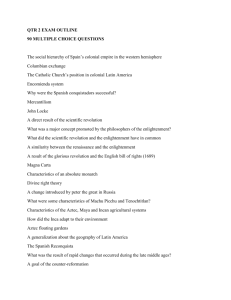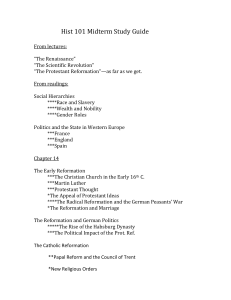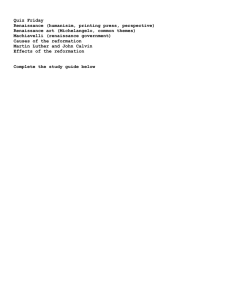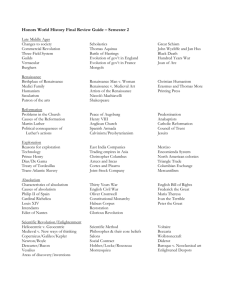Renaissance and Beyond
advertisement
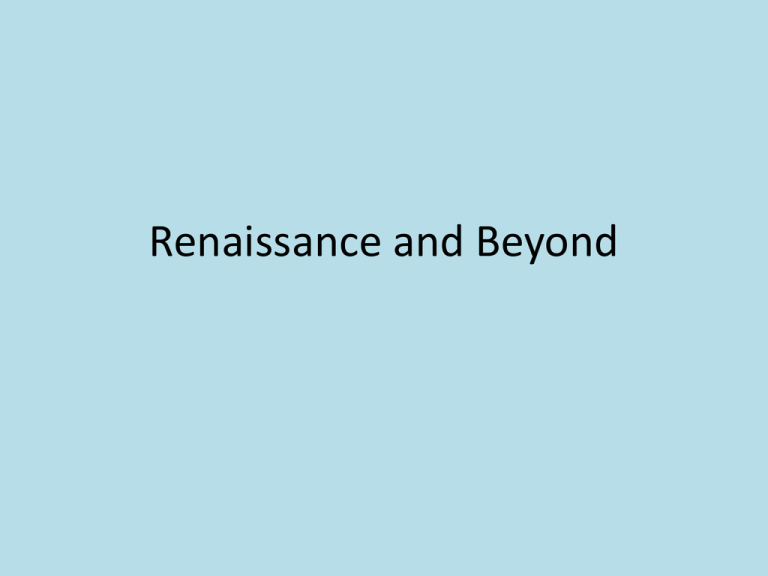
Renaissance and Beyond Crusades "Christians, hasten to help your brothers in the East, for they are being attacked. Arm for the rescue of Jerusalem under your captain Christ. Wear his cross as your badge. If you are killed your sins will be pardoned." Pope Urban II Magna Carta • When 1215 A.D. • What: paper written to limit monarchs power – right to fair trial; free travel in England, right to private property, limit king’s power to raise taxes – The framework for the American Constitution – changed England from monarchy to constitutional monarchy • Who: King John of England • Why:. Because the Barons were tired of taxation without representation The Renaissance • • • • This was an era of creativity in Europe = summary It lasted from the 14th to the 16 century = when It means rebirth in French It started in Florence, Italy = where • They were attempts by Christians to reclaim the Holy Lands from the Muslims • They occurred during the 11th,12th, and 13th centuries • They opened up trade routes and helped Europeans rediscover the ideas of the Ancients Romans • Effects: • • • • • Decline of feudalism: People moved to cities; Catholic Church played important role in daily life Trade increased Rediscover ideas of Greeks and Romans People = who • Leonardo Da Vinci- Well known inventor and artist • William Shakespeare- Well known author. Wrote Romeo and Juliet. • Martin Luther- Critic of the Catholic Church. He wrote 95 theses protesting the selling of indulgences and translated the Bible from Latin into German. • Reformation: Invention of the printing press allowed distribution of the bible. • In the counter reformation the Catholic church stopped selling indulgences but it was too late Leonardo da Vinci: Artist and Scientist Da Vinci’s The Last Supper Da Vinci’s Mona Lisa Da Vinci’s cannon drawings Model Da Vinci’s drawings Flying machine (helicopter) Self propelled cart Model Michelangelosculptor, painter, architect Holy Family Michelangelo’s Moses Michelangelo’s David Michelangelo’s/ Sistine Chapel Sistine Chapel Sistine Chapel Raphael Donatello Bronze statue of David Statue of St. Mark Renaissance spreads to the North • English writer Shakespeare wrote plays such as Romeo and Juliet, MacBeth, and Julius Caesar and revitalized the theater. Renaissance Characteristics • Art- realism, perspective, humanism (studies of the human body), less religious themes and more nature and people’s feelings • Architecture-cathedrals, no fortifications, large windows, gardens, fountains, statues Reformation • The_Reformation.asf • When: Protestant Reformation – 1517-1648 • What: – Reformation = movement to change church practices that divided the western church into Catholic & protestant groups • Who: – Martin Luther-German monk who was upset about church practices like selling indulgences •Where: •Germany then the rest of Europe •Who: •Martin Luther-German monk who was upset about church practices like selling indulgences Martin Luther Leader of Reformation The Reformation • Why: –Corruption in the Church • There was extreme wealth and corruption among many church officials • Churches started selling relics as a source of indulgences (the forgiveness of sins in exchange for money) Ninety-Five Theses • Luther was greatly upset with the selling of indulgences • October 31, 1517, Luther sent the Ninety-Five Theses to his superiors & other church officials and nailed them to the Wittenburg Church door • They were an attack on the abuses of the Church • Martin Luther was excommunicated from the church • While in hiding he translated the Bible into German so people could read it. • His followers became known as protestants because they protested the church Johannes Gutenberg’s printing press-Important invention in this period One reason is was is important is that the multiple copies of books such as the Bible became available allowing people to read and thus many follow Luther. The printing press allowed books to be printed quickly and less expensively. Age of Exploration • Who and when • Columbus (tried to sail west and discovered the New World in 1492), • Ferdinand Magellan (his crew was the first to circumnavigate the world) • Cabot (tried to sail northwest to find Asia but instead discovered Canada). • The Europeans explored the world to discover a better route for the spice trade. = why • This increased trade but also led to slavery, the spread of diseases, and religious conversion. = how it changed the world • Circumnavigate means to go around the world Scientific Revolution • Period of great scientific change and discovery during the 16th and 17th centuries. = summary and when • Saw the invention of the telescope and microscope = inventions People during the Scientific Revolution = who and more inventions • Galileo used a telescope to view the craters of the moon • Copernicus determined that the earth revolves around the sun instead of vice versa • Isaac Newton discovered gravity and created calculus and the first modern observatory. Industrial Revolution • Industrial Revolution: the change in the way goods were made (from hand to machines). = summary • It started in England in the 1700’s = when and where • England was called the workshop of the world. • Sparked on by the use of Steam Power • James Watts invents the steam engine = invention and who Industrial Revolution: • What: the change in the way goods were made from hand to machines. • Where: It started in the UK (England) then spread to the US and Europe • When: in the 1700’s • • • • • • • • How it changed the world More factories now located in cities People moved from countryside in search of work First factories were textiles (clothes) Required a labor force or workers with low pay 1838 75% of labor force were women and children Led to Capitalism or privately owned businesses Spread to Europe and U.S. BEFORE AFTER • Growth of cities led too: more of how it changed the world • -Rapid growth • -Became more crowded and dirtier • -Diseases spread like cholera and typhoid • -Widespread pollution of air and water French Revolution • French Revolution was the revolution that led to a change in France’s government from monarchy to republic = summary and where King Louis XVI and Marie Antoinette The Storming of the Bastille July 14, 1789 Angry mobs attack the prison and release all the prisoners The French Revolution • • • • • Caused by: = why Higher Taxes Large Government debt Widespread hunger The extravagant lifestyle of the nobles and kings • Rulers: Louis XVI and Marie Antoinette = who • Begins July 14th 1789 when French peasants storm the Bastille. = when and where The Reign of Terror is where 17,000 people were killed (many by guillotine) Napoleon • General Napoleon Bonaparte takes control and restores order in 1799 = who • He becomes emperor in 1804. Imperialism • Imperialism-European countries controlled the government and economies of discovered lands = summary • Needed raw materials to fuel the industrial revolution = why • Brought the English language all over the world. = how it changed the world Colonialism and Cultural Diffusion • The British would end up establishing colonies all over the world • This led to the saying “The sun will never set on the British Empire” • Example: British colonized India. In doing so they changed India's culture. Over 80% of all people in India speak English, and India is covered by railroads and power lines built by the British Brain Pops • http://www.brainpop.com/socialstudies/ushis tory/industrialrevolution/ • http://www.brainpop.com/socialstudies/worl dhistory/frenchrevolution/ • http://www.brainpop.com/science/famoussci entists/galileogalilei/ • http://www.brainpop.com/socialstudies/ushis tory/britishempire/
